#adventure design
Explore tagged Tumblr posts
Text
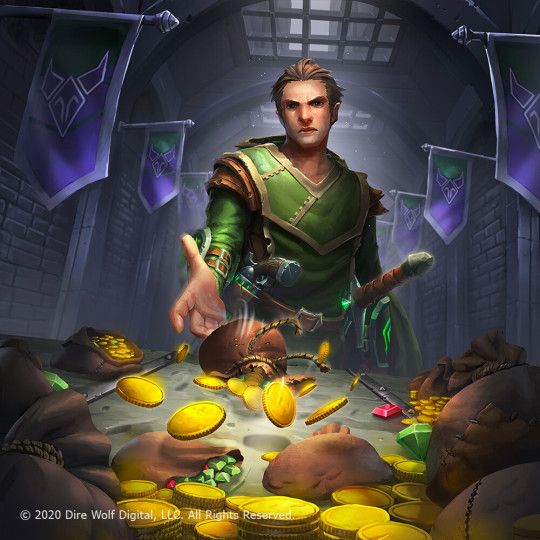
DM Tip: The Debt Always Comes Due
Isn't it weird how little we engage with gold as a real gameplay system? Sure, at low level wealth makes a great questhook, the party is usually hurting for a payout so that they can afford necessary gear upgrades/ubiquitous healing potion restocks/their next trip to the magic item shop. After a while though the promise of raw wealth loses its lustre, and the party is less likely to go out of their way to accept bounties, go off chasing treasuremaps, or accept gigs from shady patrons.
Generally I'd advise that this is a sign that your party are done being run of the mill sellswords, and it's time to hit them with a big epic questline that's focused more on emotional and narrative stakes than base currency. That said, sometimes you want to run a longer adventure arc that's centred around the acquisition of wealth, but to do that, you're going to need to go against the grain on one of the foundational assumptions that underpins D&D both mechanically and narratively.
TLDR: If you want your party to be motivated by gold past their first big pay off you should consider using a "wealth hurdle", which in short is a narrative and gameplay challenge that forces them to collect not only more gold than they already have but also more gold than they could get doing what they've been doing so far. This can be anything from a crimelord calling in a debt on them or one of their allies, a powerful monster swooping in and demanding tribute, comissioning some grand construction, or funding the defence of a region. Having the hurdle active should cause problems for the party, and not clearing the hurdle before a perdetermiend deadline will immensely bad things to happen. This will force the party to take risks they otherwise wouldn't, giving a high degree of focus to their subsequent adventures that they wouldn't have if they were content.
What we're trying to fix:
At it's core, D&D is a power fantasy, and a good chunk of its gameplay mechanics regardless of edition are about acquiring new strengths, options, and assets. These assumptions are likewise built into the genre and narrative structure of most campaigns: Heroes undertake quests usually for the promise of some reward, gain experiance/hit milestones along the way, and eventually stumble across some kind of loot drop at the end. There's nothing strictly wrong with this, but it does mean that all the resource problems the heroes face in the early game (and the inbuilt motivations that come along with them) are all but resolved by the time they hit the next gameplay tier.
This is complicated by the fact that outside of 3rd party options there's not much to spend money on. The DMG (which you should totally ignore) say you shouldn't let them buy magic items, and the common wisdom would say "let them buy a keep", but that solution only appeals a niche selection of adventuring parties.
Using Weath Hurdles turns acquiring gold not just into a quest goal but a gameplay challenge, forcing your party to scour the land for potential sources of wealth (and risk upsetting whoever or whatever happens to be currently holding it) and take on challenges they'd never normally attempt if there was only survival/personal enrichment at stake.
Food for Thought:
Tradional d&d structure has the party getting a huge payout at the end of their adventure in the form of a bosshoard or questgiver reward which is a very backloaded "you can have your dessert after you finish your greens" sort of attitude. Consider switching it up sometimes: have the party's patron or employer give them a small stipend to spend on kitting themselves out, have an early game treasure haul so the party can have a mid-arc shopping episode. This is especially useful in higher level games where your party may go weeks to months without a level up as it preserves the feeling of progression and gives them new toys to play with in between the big character defining abilities.
Recently I've been learning my way around blades in the dark (can't reccomend it enough btw), and just like any other time I've wanted to learn a new ttrpg system I'm having to do a bit of neural rewiring when it comes to figuring out how to write and run sessions of the game. Coin in BitD is both an XP (used for upgrading the party's shared crew sheet) a resource (burned to upgrade the results of various rolls) and a stat ( rolled to see if the players can lay their hands on various hard to come by items). It didn't really click for me until my first group messed up really badly on what was supposed to be their introductory adventure and pissed off the local crimeboss. I was just going to have him bully them, lock them up and then have a jailbreak the next session ( it's what I'd do in d&d), but on the fly I had the idea that he'd let them go with a massive debt they needed to pay off, which forced them to either pay him a percentage of their takings on all future jobs, or do small jobs in utmost secrecy so that they could build up their own strength under his nose.
Interestingly enough, the d&d game where I thought player wealth as a resource was most interestingly used was Dimension 20’s starstruck Odessy, which was a conversion of the amazing fanmade starwars5e system. Starstruck is a parody of hypercapitalism and aptly uses money as both a narrative and gameplay feature. One character is stuck paying weekly insurance premiums on a debt he would never be able to pay down forcing him to act recklessly to acquire wealth in the immediate future. Another character was a economic and political power player and some of the best moments in the series come from her high stakes wheeling and dealing and bouncing money between accounts while the rest of the group engages in epic space battles; the rest of the crew might’ve barely got their ship out of the dogfight, but she’s the one who ensures they can pay for the repairs once they get to the space dock. None of this would be possible without completely ignoring the normal constraints of wealth per level: gaining and losing huge sums based on moment by moment player decisions, The need for them to play along with the absurist gig economy to boost their rating and get better paying jobs, making a devil’s bargain with a corporate sponsor all so that they could risk their lives in a deadly arena fight all for the (very unlikely) chance of winning the equivalent of a million GP. Not every campaign should, or even could so focus on money in this way, but it was FASCINATING to watch it in action.
Artsource
323 notes
·
View notes
Text
People are quick to point out that Dungeons and Dragons is designed for dungeon crawler adventures and a lot of the problems players experience come from trying to use the system for things it wasn't designed for. We've all read a hundred think pieces about how it's bad actually that DnD has rules that most players ignore and how there's a lot of unnecessary complexity. Everyone knows that the game is awkwardly trapped between a style of fantasy steeped in mid 20th Century ideas about race and a desire to make the game as inclusive as possible.
But for some reason, I'm the only person here willing to point out the biggest and most obvious flaw with Dungeons and Dragons! Everyone else is too scared to say it, so I guess I will have to be the one to point it out!
The cramped dungeon environment is a really bad fit for dragons. The ability to take to the wing is an important aspect of dragons, both strategically as a game element and mythologically as a representation of unconstrained power. If you put a dragon inside of a dungeon, you are severely limiting the dragons ability to control the pace and shape of the battle. The ability to make tactical fly-by strikes and disrupt their enemies, both with blasts of fire breath and by snatching specific targets and moving them away from their defensive positions, are incredibly important for making dragons complex, engaging, and terrifying foes.
Fighting a dragon inside the dungeon does make sense for a group of level 1 noobs fighting their first white dragon hatchling. You don't want those players feeling overwhelmed, so limiting what the dragon can do makes for a better encounter. However, once your players are familiar with the game, take that adult red dragon and put it outside! The dragon will be able to take full advantage of its more unique abilities and your players will feel challenged to come up with clever solutions to limit the dragon's abilities and turn the tides of battle in their favor. Having to constrain and ground the dragon and then fighting the beast head-on creates a satisfying flow to combat, where the players' actions can significantly impact the battle beyond just reducing the enemy's hit points.
12 notes
·
View notes
Text
GREEN MILK | #004 | proclamations from the game design mountain
Me, bracing my wizard hat: The proclamation I'm yelling at the top of my lungs while great winds steal away my voice atop the Game Design Mountain: The medium of ttrpg systems with adventure modules must be forever changed! Instead of the Roles of play being glued to the System (character playbooks & classes attached to respective games), character archetypes should* be assigned at the level of the Module, for example: You roll 1d8 on the index page of Revenge of the Radioactive Basement Gators: you got "7 - The Inheritance". No one else will be this role – you check the box and turn to page 7. Beneath the shattered facade of wealth, your prompt reads: "Clear all wounds when shit finally hits the fan – you adapt instantly, like you were born for this, like this is all there ever was. You're ready to die down here. You're ready to kill. Your names are Death and Glory, and you understand each other." My wizard hat, soaring high above the scree of the Game Design Mountain:
From my end of April newsletter, additional thoughts lurk within!
#proclamations from the game design mountain#ttrpg#indie ttrpg#ttrpg design#tabletop#osr#ttrpgs#ttrpg community#adventure design#D&D#dnd#dungeons & dragons#dungeons and dragons#adventure modules#green milk
15 notes
·
View notes
Text
"There is an idea that rules-lite games don’t require adventures and scenarios the way crunchier games do. I think this is an idea shared mostly by younger gamers, because modern games that use Powered by the Apocalypse designs generally encourage the GM to build things improvisationally with players.
I myself had the wrong idea for a while, because the Random Event generation in Maid RPG more-or-less turns GM prep into an optional thing. The first time I read Risus, I was a bit confused. I thought to myself, Ok, so this is a simple game, often lauded as a great game for short-notice one-shots. But what exactly do you do?" - Sabrina
9 notes
·
View notes
Text
Illusory Sensorium ran a game of Barkeep and their writeup is one of the clearest signs that the hard work we put in was worth it.
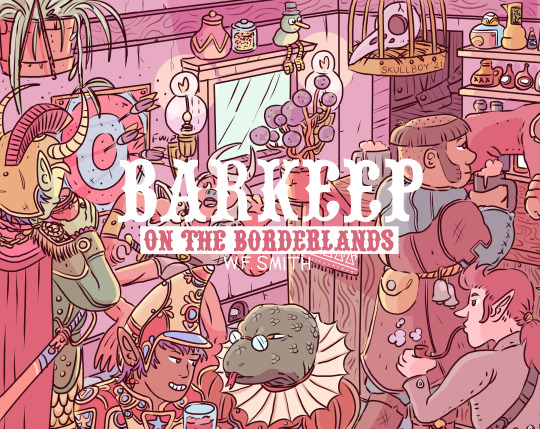
Here's the recap. I genuinely was laughing out loud a few times. Highly recommend: https://illusorysensorium.com/b1-wand-of-embiggening/
If you want to delve into the design theory of Barkeep, keep reading! ⬇️
When we were working on the book, we came up with a sort of mantra for the encounters: Is it sticky? Is it toyetic? Do the NPCs have means, motive, and opportunity? Is there information, choice, and impact?
That's a lot of jargon, and it's been synthesized from across multiple sources. Prismatic Wasteland summed it all up here:
Sticky means that the encounter isn't something the characters can avoid. It sticks to them.
Toyetic came from false machine as well, but also from a post now lost to time from Rebecca Chenier. Basically—will the players and GM want to pick up and play with the encounter?
MMO is just a way to conceptualize NPCs in a simple, understandable form.
ICI is from Bastionland. We can't make informed decisions without information, and there's no point to making decisions if our choices don't matter.
Building the encounters meant looking at each of them carefully and considering those foundational elements. Not EVERY encounter needed every single thing. In fact, with the way WFS wanted to write the book, each encounter had to be relatively short and packing a punch.
A really really sticky encounter didn't need to be as toyetic, and a really fun and interesting encounter that the players would NEED to investigate didn't need to be all that sticky. Everything is a gear of a different size that turns the whole engine.
Illusory Sensorium thinks that they ran the game "wrong" and I disagree. They used the tools provided by the book and had fun! Mission Accomplished!
But one thing they point out very early on is how they "trusted" the encounters in the book as written. The very first one they got is quite simple: 54 skeletons in a conga line, labeled like playing cards.
Incredibly toyetic, not sticky. But the players immediately joined in!
They could have moved on, but that situation was too tantalizing to skip. The rest of the game unfolded from that first encounter, and was filled with shenanigans. The work we put in—hand crafted encounters—worked out!
I'm incredibly proud of the work everyone on the team put into Barkeep, from the writers, artists, and fellow editors. I'm especially proud that people are playing the adventure and having fun. People playing the stuff you've worked on and made is the best feeling as a creator.
Thanks for reading. There's a lot of links in this thread, because I love tracing the history of things. It's no surprise that blogs are the home for so many of these ideas—word of mouth and common practice are easily lost forever when not documented!
The bloggies, a celebration of rpg blogs, are happening now! I've got a post in the running, and I'd love it if you voted for it. My competition is FIERCE (and I recommend all the nominated posts as reading material!)
Vote for RANSACKING THE ROOM today!
#indie ttrpg#ttrpg#gming#rpg#blog#roleplaying#tabletop rpgs#ttrpg community#ttrpg theory#rpg theory#adventure design#adventure
19 notes
·
View notes
Text
Get Random With Me
I wanted to make an adventure site using the tools presented in the book and I wanted to show how I go about it. The first step is in gathering results from BREAK!!'s tables. I prefer to start on p342, and going through the section on Encounters. I'll use 2 results from some tables but only 1 from others. That'll give me a list....
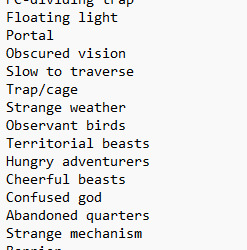
From there, I start matching up elements. This is where rolling multiples of some items can come in handy. This quickly establishes a lived-in narrative in a way that makes this adventure make sense, because no element exists in isolation. It's about how everything relates to each other.

I don't feel like the restraints trap really fits in with everything else in a way which speaks to me so I may scrap that result but I'll leave it in for now. Let's look at what we've got so far: 1. A hidden grave (read: unmarked) in a difficult-to-cross, eerily serene area suggests to me a forgotten cemetery of some kind, one of those places like you see in Dark Souls or New Orleans or rural areas where folks are just....piled on each other over time. Peaceful and nice in its way but not calm in a welcoming way. If we're recovering lost tech then the strange mechanism may be something that the grave's occupant wanted to take with him....that may even explain why the grave is unmarked. May be some kind of portal device. An inventor who wanted to protect the world from what they created? 2. Our noble could be someone who coveted that technology and has spent a long time searching for it. The birds/skree are his eyes and ears, and Medium-sized growls act as his muscle. He may be old. He's not even for sure a "he" but cmon wasting all this time pursuing this power that doesn't belong to him when his station could afford him ANY other opportunity? That's a guy. He's been digging, probably using a grid system in search of this grave....a mechanism by which he can seal off sections of the cemetery while he searches could make sense. Probably a magical barrier, a ward.... 3. I like the idea of making the fog more of a local hazard than a trap, and making that what's obscuring everyone's vision. I wouldn't make it too toxic in terms of burning through players' hearts but I might make it toxic enough that only those with Rebreathers can recover hearts, including after a Fight. The glowing light leading them through the fog is a nice idea....the spirit of the departed inventor? It's also raining frogs (ribbittys?) who are unaffected by the fog. 4. Abandoned quarters could represent the home of the inventor on the grounds....is this his ancestral stead, or was he a brilliant gravedigger?....the confused god imprisoned within could have been the key to unlocking the secrets of the portal device. The god may not have a full understanding of time or death, or for that matter of imprisonment; this can be a god in the sense of a force less than a full personality. It may still be expecting the inventor to turn up. I've watched enough Danny Phantom that it makes sense to have the portal device be used to seal away the "hungry adventurers," which could be your standard walking dead but which I prefer to make a kind of ravenous semi-spectral horde, one which perhaps terrorized this plain in the wake of a great battle until sealed away. That wouldn't leave much opportunity for an abandoned home or a cemetery to develop, so maybe they only manifest at certain anniversaries....
Thinking about how the opening to Ninja Gaiden or an oldschool anime recap would handle this helps to put things into perspective for me. Also, when in doubt I just think about the images I want to capture. In this case there are 3: the entity/horde being sealed away as they try to breach into the world again, the noble villain surrounded by his animal servitors, and the uncomfortable effort of clambering over markers and amphibians while following a light in the fog. If I wanted to capture the restraints-trap, I'd do so with the lashing, grasping limbs of the phantom horde as they first escape their containment, moving and flailing as one creature... "In the misty ruins of a mansion's grounds, a bitter aristocrat continually searches for the magical technology he believes is rightfully his. Our heroes must brave the dangers of the Coughin' Gardens or else an ancient curse will be re-visited upon the surrounding countryside."
There's a version of this scenario where the noble listens to reason and it's only through the united efforts of the company, the noble, the god, and the spirit of the inventor that the device is able to renew the seal against the horde, and their opposition comes from a mutiny by the carrion-feeders the noble employs as his spies. Manipulated by the same deathly forces which bind the hungry horde in its sinister cycle...
But it's also an interesting PLACE to spend a session and at least 3 interesting figures around whose struggles the scenario revolves. There's a handful of clear goals. I'm also a big fan of scenarios where things are already moving toward either escalation or resolution by the time the players gets involved. It lets them choose whether to bring a deft touch or a Gordian knot solution to the proceedings when it feels less like all these people were standing around waiting for some adventurer to come and do everything for them; players feel less like their level of investment is being assumed on their behalf.
Battlefield areas can be Isolated or Precarious, most of them can be Obscured, and I'd keep the threat of suffocation at bay and out of a fight's logistics if I were to employ my heart-recovery restriction I mentioned earlier....
Anyhow, that's what I'd do...
#break rpg#break!!#break!! rpg#break!! inspiration#breakrpg#rpg#ttrpg#adventure design#game design#random encounters#bustin makes me feel good#break!! tools
6 notes
·
View notes
Text
Been thinking about impermanent victories in TTRPGs, especially after last night's post about the ghost ship. I think more adventures should have them. Especially when weird supernatural things are involved, it should be a bit of work to win for good.
A vampire won't die for good. A demon will rise from its sulphurous ashes. An alien queen can regenerate from a single cell. Kill a famed assassin, and one of her apprentices will take her name and MO. The ghost ship will rise from the depths again.
The trick is allowing the players to get the permanent victory be being clever, or doing their homework beforehand. Maybe a clever player comes up with a workaround, or maybe their character studies the problem before facing it.
The vampire is destroyed for good by staking its heart. The demon can be banished by dousing its ashes in holy water. The alien queen can't regenerate from wounds caused by cold. The assassin's fame is dispelled by nonlethally humiliating the next in line. The ghost ship's curse must be suppressed by a shaman before the vessel is sunk.
There's a trap here too, though. This can't be overused. And it's easy to use badly. Let your players have their wins most of the time, but keep this in your back pocket. It's a nice way to add a little spice to your games.
3 notes
·
View notes
Text
The Shattered Tower (102)
I am Playing ShadowDark with my kids, in the mini campaign setting of The Gloaming from Cursed Scroll #1.
Hex (102) “The Shattered Tower” has a short blurb about a ruined keep with a trap door leading to a cistern with something slithering in the murky waters.
Time to flesh this out:
The Thistlewood Keep is centuries gone, but a rumor remains of a priceless diadem, never recovered. The legend varies widely and no detail seems to remain the same from one re-telling to the next, save for one. The Princess of Thistlewood Keep, moments before destruction, took her family’s most cherished possession and hid it away. Though the enemy razed the keep, the treasure was never found! Much speculation has been made, and many a young adventurer has often dreamed of finding the treasure!
More recent generations have used the keep as a sort of initiation or hazing ritual, much like a snipe hunt. Young adventurers have often been sent by their older siblings to go find the treasure and prove their worth. After a trek of adventure, or boredom, the children are lucky to return with an odd button, or a piece of a broken plate from the keep.
And more recent still, a few months ago, there has been a report of a pair of monstrous birds nesting in upon the ruined tower. Their bodies are like giant eagles with the head of a mighty stag! Their talons and antlers are iron hard, and razor sharp! Hunters have warned all the townsfolk and all the children to avoid the area and STOP these hazing rites, for this monsters will most surely kill and eat anyone who disturbs it’s nest. There have been a few failed attempts to kill these monsters ending in the death of several hunters each time. For now, hunters are avoiding coming too near the area.
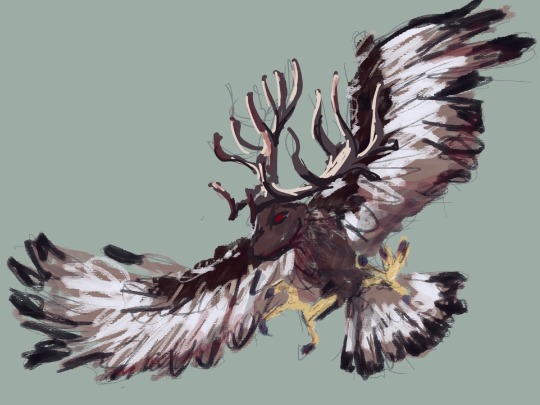
Elsewhere in the Gloaming, a camp of Outlaws led by Grieves Redthorne. Recently, a group of goblin bandits attempted to waylay some of his men, but quickly surrendered and begged mercy, and to make it up to Redthorne and join his group. For this crime, the group was offered a quest to atone for their transgressions. “Bring back the Thistlewood Diadem!” The goblins, unaware of the monstrous birds made haste to appease this Grieves Redthorne, grateful for this uncharacteristic offer of mercy!
When my players arrive, there is a chance the perytons will be present at the nest, but I hope to get them into the cistern where they will meet the goblins. Sinred, the now leader of the goblin group will explain how they’re all surely doomed! Because the perytons have killed 2 of their group and won’t let them leave the cistern! And even now, lurking within the cistern, a giant snake which has eaten another of their group! Sinred will beg the PC’s for help, and even offer the treasure if the party helps them escape! Sinred claims that before Dink was swallowed whole, by the snake, he had clasped in his hands, a small treasure chest! Sinred and Urn, the remaining 2 goblins, were too afraid to fight the snake on their own, and after it’s meal, the snake slithered away and ignored them, as they did not attack it.
If my players defeat the snake, they will indeed find a goblin and a waterlogged chest containing the diadem. Sinred will attempt to betray the PC’s and steal back the diadem if given half a chance.
The perytons are a great threat to the PC’s at level 2. And I will give the PC’s ample warning to not stick around to fight them.
The PC’s will find another exit, a crack in the wall of the cistern, that will lead into a vast cave system. I have some tables ready with content from Veins of the Earth, and the ShadowDark core rules. I want to open up the idea of cave exploration, as we have not yet done this, and also have some possible shortcuts, throughout the Gloaming.
Peryton
AC 14, HP 30, ATK 1 talon +5 (2d6) and 1 tail +5 (1d8), MV double near (fly), S +2, D +4, C +0 , I +2, W +0, Ch -2, AL C, LV 6
#old school renaissance#ttrpg community#ttrpg#procreate art#ShadowDark#Cursed Scroll#Diablarie#The Gloaming#hexcrawl#adventure design#campaign design#dnd#dnd adventures#Peryton#procreate doodle#procreate sketch
2 notes
·
View notes
Text
The Call to Adventure by Helpful NPCs
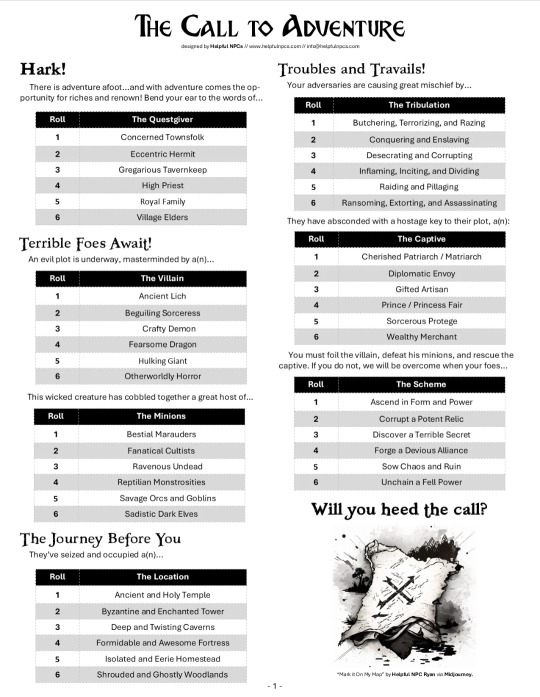
#helpful npcs#call to adventure#adventure design#adventures#generators#generator#chart#charts#table#tables
5 notes
·
View notes
Text
official dnd post

141K notes
·
View notes
Text




㋡🥀
colors of the sky.
#nature#art#design#beauty#scenery#photography#sky#cute#photographers on tumblr#artwork#artists on tumblr#cottagecore#naturecore#plants#inspiration#motivation#alternative#aesthetic#travel#landscape#paradise#adventure#exlore#traveling#indie#style#vintage#retro#pretty#dark academic aesthetic
110K notes
·
View notes
Text

Drafting the Adventure: To the dungeon!
Recently I worked out a framework for running exploration based adventures , and while a lot of people seemed to like it, a few folks wrote in asking how it might work in practice. I’m only too happy to provide an example, as it will likewise give me the chance to demonstrate how to combine a wilderness adventure with a dungeon adventure, which is something I wanted to do anyway.
Background: the party is sent off to seek an arcane mcguffin contained in an ancient ruin, with the caveat that no one really remembers where the ruin might be. As such they’ll have to explore a stretch of wilderness looking for signs of old habitation before getting to delve the dungeon itself.
Setup: In addition to gearing up The party might want to talk with some locals to get information about where they're going, which will allow you to drop clues about further places they cam explore. Any Entry marked with a (G) can be hinted at in gossip and research, providing them a hint about where to go.
FIRST ZONE : The Ancient Plains
"Cool winds steal the warmth from your cheeks as your party steps into the wilderness, your goal and the mountains far in the distance and a vast rolling grassland before you. This place was the site of a great battle that nearly destroyed your home, but is now quiet save for the murmur of the tallgrass and your own footfalls.
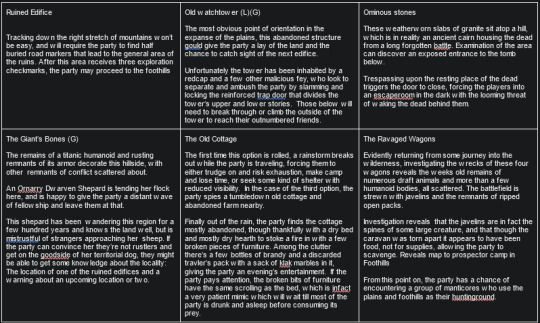
Design Note: The party can either choose to head to one of the locations they've already heard about/discovered, or spend time trying to find a new location with a perception or survival check, with you rolling a die to decide which one to point them at first. Once the random encounter is unlocked, add one die to the pool every time they travel to an area, and two die if their searching for a new area falls below a reasonable dc.
SECOND ZONE: The Forgotten Foothills
"Like the fingers of a grasping titan, the roots of the mountain-range pull at the earth giving rise to steep ascents and sudden valleys. The trickle of pure glacial melt runs in small streams over this uneven landscape, giving you a refreshing if bonechilling respite from your long travels."

Design Note: Now rather than making simple progress, the party needs to actively hunt for the location of the ruins, with the understanding that taking a surface look at different locations is going to bring a random encounter or two down on their heads REAL fast.
Also shoutout to Yithini, my homebrew goddess of ascension in all its forms.
THIRD ZONE: The Cascading Ruins
"It was no wonder it was so hard to find this old fortress, as the waters pouring down from the cliffs above seem intent on wiping it from the mountainside. The noise and the crush of endless water rumbles in your bones as you make your approach, up a slick half eroded stair that might've been part of the structure's battlements. Most of the structure is lost in the pool of rushing white water below, but a few stretches of old fortification still manage to withstand the siege of time. "
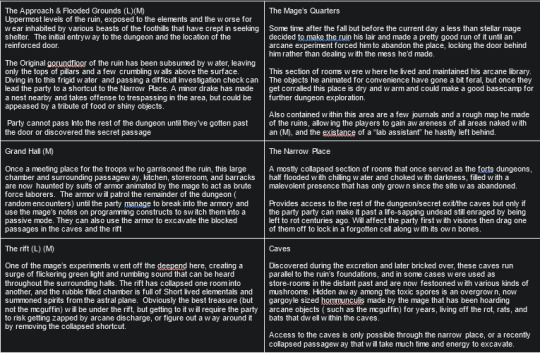
Art
#drafting the adventure#mountain#field#adventure design#dungeon design#dm tip#dm advice#treasure hunt#dungeon#dnd#dungeons and dragons#d&d#ttprg#pathfinder#yithini
196 notes
·
View notes
Text




When i say I'm OBSESSED..✨️☀️🌙
#aesthetic#photography#witchcore#witchblr#wicca#food#foodporn#moon#sun#astrology#art#artists on tumblr#design#creative#cakes#cake#dark academia#light academia#cottagecore#angels#landscape#paradise#travel#explore#nature#travelling#adventure#garden#gardencore
28K notes
·
View notes
Text



#landsccape#paradise#nature#adventure#explore#travel#travelling#naturecore#cottagecore#gif#mountains#moodboard#cottage witch#green#fairycore#aesthetic#photography#flowercore#farmcore#fall aesthetic#curators on tumblr#artists on tumblr#dark academia#light academia#photographers on tumblr#beauty#design#scenery#landscape#forestcore
27K notes
·
View notes
Text
#adventure tshirt#adventure#adventure design#hiking#trekking#camping#learn into wid#wild#alamnesia#pendakian gunung
1 note
·
View note

